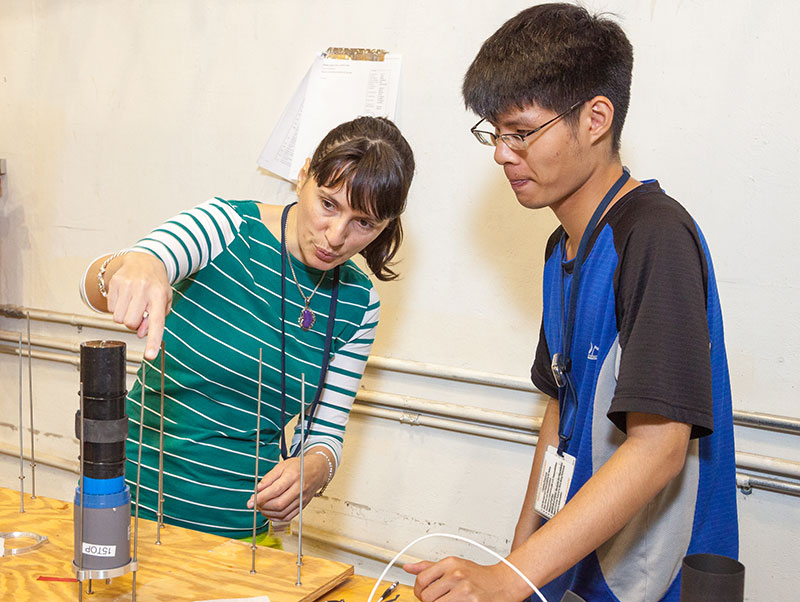Simona Malace
Simona Malace, a staff scientist at Jefferson Lab, likes to refer to protons and neutrons as “tiny laboratories” that enable her studies of the heart of matter.
For decades, physicists like Malace have probed protons and neutrons, particles known collectively as nucleons, to study the strong interaction.
The strong interaction holds most ordinary matter together: it binds protons and neutrons to form the atomic nucleus, and smaller particles called quarks to form nucleons themselves. It’s one of the four fundamental interactions.
“The universe we are moving in is governed by these interactions,” says Malace. “So knowing about them is like knowing about the world around you.”
To learn more about the strong interaction, Malace and more than 30 other scientists will continue the tradition of using nucleons as tiny laboratories for studying the strong interaction in a new experiment scheduled to run soon in Jefferson Lab’s Experimental Hall C, titled E12-10-002: Precision measurements of the F2 structure function at large x in the resonance region and beyond.
The “tiny laboratories” in E12-10-002 will be inside hydrogen and deuterium targets. The hydrogen nucleus contains a single proton, whereas the deuterium nucleus contains both a proton and a neutron. Malace and her colleagues will shoot high-energy electrons at the targets and track how the electrons scatter from the protons and neutrons they encounter in the targets.
Analyzing the electron-scattering patterns will allow the scientists to map the inner structure of the nucleons, giving them a more precise picture of how quarks and gluons interact inside nucleons. This data will provide scientists more information about the strong interaction that dictates their activity.
Several decades ago, researchers at DOE’s SLAC National Accelerator Laboratory (formerly the Stanford Linear Accelerator Center, SLAC) conducted a similar experiment and found first experimental evidence for the existence of quarks. The SLAC team shot an electron beam at proton targets and used the electron-scattering patterns to deduce that every proton is made up of fundamental particles.
For the over three decades since that time, this kind of fundamental experiment, termed “deep inelastic scattering,” has been carried out at laboratories all over the world, including CERN and DESY. Yet, this research still has a role to play in the 12 GeV era at Jefferson Lab, which offers unprecedented access to the regime where the quarks that give the nucleons their unique quantum numbers reside. These quantum numbers are used by physicists to label a nucleon’s identity.
"We are building on the earlier SLAC experiments by taking advantage of Jefferson Lab's higher luminosity," Malace explains. This will allow scientists to glean more detailed information than ever before.
E12-10-002 is one of the first experiments to run in Experimental Hall C following the completion of the 12 GeV Upgrade.
“This is the first time we will take physics data after years of being down, so that’s very exciting,” she says. “The upgrade helps us go to a kinematic region that was not accessible before at Jefferson Lab.”
Jefferson Lab scientists have formed a collaboration with the Coordinated Theoretical-Experimental Project on Quantum Chromodynamics (CTEQ). The goal of the CTEQ-Jefferson Lab collaboration is to learn more about the strong interaction, with an emphasis on the part of this science accessible with Jefferson Lab’s unique combinations of energy, luminosity, targets and polarization.
E12-10-002 will add to the international pool of data that the CJ collaboration is using, helping scientists further understand nucleons, strong interactions, and, consequently, the world around us.
Malace says conducting experiments at Jefferson Lab allows her to work with the neatest equipment and to employ the coolest analysis techniques. It’s a realm of exploration that she is particularly passionate about sharing with others.
“I am in pursuit of some puzzle to solve every single day. I cannot imagine anything better to do,” Malace says. “I have this dream that during my career as a scientist I will see many more women and other minorities joining the ranks of physicists at the national labs and universities. This would make it perfect for me!"
By Chris Patrick


